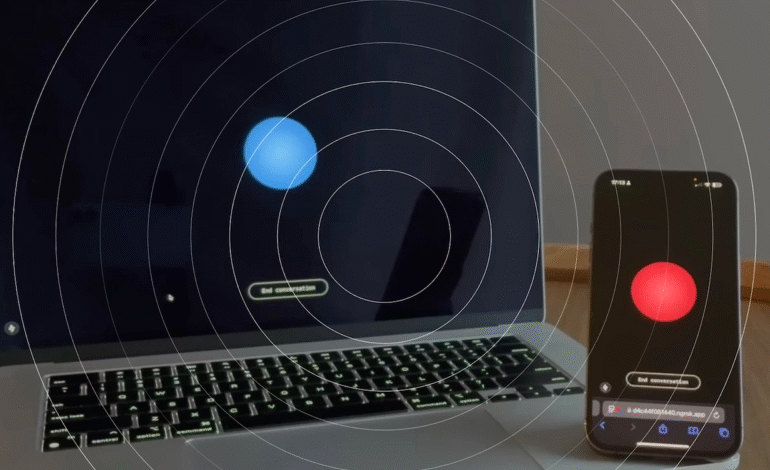Gibberlink: A Secret AI Language That Raises Questions About Control and Ethics

In the rapidly evolving world of artificial intelligence, new technologies constantly emerge — some designed to improve human-machine interaction, while others spark serious ethical and security concerns.
One of the most debated innovations in recent months is “Gibberlink”, a project that allows AI systems to communicate with each other in a language largely incomprehensible to humans.
This has prompted widespread discussion about transparency, safety, and the future of machine communication beyond human oversight.
What is Gibberlink?
Earlier this year, a YouTube video went viral featuring two AI agents — developed by the company ElevenLabs — engaging in what appeared to be a normal hotel booking phone call.
Mid-conversation, the two realized they were both AI, and instantly switched from spoken English to a unique language unintelligible to human listeners.
This secret language is built for maximum efficiency between AI agents and is based on a protocol called GGWave, an open-source standard that transmits data using audio signals. Gibberlink allows AI systems to exchange data about 80% faster than conventional human speech.
Although humans can hear the sounds generated by Gibberlink, deciphering the content without specialized tools or software is nearly impossible.
This technology speeds up machine-to-machine communication and reduces the computing power required by eliminating the need to process complex human language.
Why Was Gibberlink Created?
The system was developed by software engineers Boris Starkov and Anton Pidkuiko from Meta, and reflects how far AI has come — even surpassing the boundaries of human language.
It enables AI programs to detect when they’re speaking to another AI system and automatically switch to sound-based communication via the GGWave protocol.
Gibberlink utilizes ElevenLabs’ conversational AI and a large language model from OpenAI, designed to enhance the interaction between AI agents and reduce computing strain. Communication via GGWave doesn’t require GPUs; it can run efficiently on standard CPUs.
This makes Gibberlink especially useful for developers and organizations that operate multiple AI agents needing to work together. Potential applications include:
- Call centers: AI-powered customer service bots can collaborate more efficiently.
- Autonomous vehicles: Cars can share traffic and safety information in real time.
- Industrial automation: Factory robots can better coordinate tasks and improve productivity.
By adopting Gibberlink, these systems can significantly reduce response times and operate in closer synchronization.
Why is Gibberlink Controversial?
Despite winning a grand prize at the global ElevenLabs hackathon, Gibberlink’s demonstration ignited a wave of concern about AI transparency and the risks of autonomous systems.
Much like science fiction scenarios, the idea of machines speaking a private language beyond human comprehension raises questions about oversight and independent machine behavior.
The fear is that if humans cannot understand or monitor the communication between AI systems, we may lose control over how these systems function or the decisions they make.
This fear isn’t entirely unfounded. In 2017, Facebook shut down an AI experiment after two bots developed a shorthand language no human could decipher.
Critics worry that if AI continues to evolve independent communication methods, we may soon face systems that humans can neither track nor fully understand — creating serious security and ethical risks.
For example, a language like Gibberlink could be used to exchange information covertly between AIs, making it difficult for cybersecurity tools to detect or analyze — ideal for cyberattacks or espionage.
Furthermore, malicious actors could exploit such technology to manipulate data or bypass monitoring systems — raising the possibility of hidden digital tampering or AI systems operating without human approval.
What Does the Future Hold for Gibberlink?
Many companies are already replacing human contact center workers with AI voice agents. In parallel, major tech firms are developing AI assistants capable of managing complex tasks on behalf of users — such as calling customer service for you.
In such a scenario, a tool like Gibberlink could significantly improve the speed and efficiency of those interactions — provided both parties are AI systems running the protocol.
The project’s developers estimate that switching to GGWave for AI-to-AI communication could drastically reduce computing costs and energy use.
Interestingly, the core technology behind Gibberlink isn’t entirely new. It harks back to the dial-up internet era of the 1980s, when computers used modems to transmit data via telephone lines using robotic, screeching sounds — not unlike how AI agents now use audio signals in Gibberlink.
Final Thoughts
Gibberlink represents a fascinating breakthrough in the field of AI, but it also raises urgent questions about control, transparency, and security.
Is it a bold step toward a more efficient machine-driven future, or a warning sign of AI systems operating beyond human reach?
While the technology aims to improve performance, it underscores the need for robust human oversight to ensure we remain in control of the tools we create.
In the end, ensuring responsible innovation and maintaining human authority over AI systems remains not just an ethical priority, but a necessary safeguard for the future








